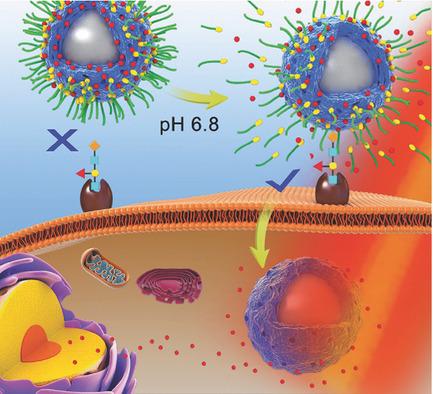Our official English website, www.x-mol.net, welcomes your feedback! (Note: you will need to create a separate account there.)
Dynamically PEGylated and Borate‐Coordination‐Polymer‐Coated Polydopamine Nanoparticles for Synergetic Tumor‐Targeted, Chemo‐Photothermal Combination Therapy
Small ( IF 13.3 ) Pub Date : 2018-02-12 , DOI: 10.1002/smll.201703968 Shucheng Liu 1 , Jianming Pan 1 , Jinxin Liu 1 , Yue Ma 1 , Fengxian Qiu 1 , Lin Mei 2 , Xiaowei Zeng 2 , Guoqing Pan 3
Small ( IF 13.3 ) Pub Date : 2018-02-12 , DOI: 10.1002/smll.201703968 Shucheng Liu 1 , Jianming Pan 1 , Jinxin Liu 1 , Yue Ma 1 , Fengxian Qiu 1 , Lin Mei 2 , Xiaowei Zeng 2 , Guoqing Pan 3
Affiliation

|
Multifunctional nanomaterials with efficient tumor‐targeting and high antitumor activity are highly anticipated in the field of cancer therapy. In this work, a synergetic tumor‐targeted, chemo‐photothermal combined therapeutic nanoplatform based on a dynamically PEGylated, borate‐coordination‐polymer‐coated polydopamine nanoparticle (PDA@CP‐PEG) is developed. PEGylation on the multifunctional nanoparticles is dynamically achieved via the reversible covalent interaction between the surface phenylboronic acid (PBA) group and a catechol‐containing poly(ethylene glycol) (PEG) molecule. Due to the acid‐labile PBA/catechol complex and the weak‐acid‐stable PBA/sialic acid (SA) complex, the nanoparticles can exhibit a synergetic targeting property for the SA‐overexpressed tumor cells, i.e., the PEG‐caused “passive targeting” and PBA‐triggered “active targeting” under the weakly acidic tumor microenvironment. In addition, the photothermal effect of the polydopamine core and the doxorubicin‐loading capacity of the porous coordination polymer layer endow the nanoparticles with the potential for chemo‐photothermal combination therapy. As expected, the in vitro and in vivo studies both verify that the multifunctional nanoparticles possess relatively lower systematic toxicity, efficient tumor targeting ability, and excellent chemo‐photothermal activity for tumor inhibition. It is believed that these multifunctional nanoparticles with synergetic tumor targeting property and combined therapeutic strategies would provide an insight into the design of a high‐efficiency antitumor nanoplatform for potential clinical applications.
中文翻译:

动态聚乙二醇化和硼酸盐配位聚合物包被的聚多巴胺纳米粒子用于肿瘤靶向的化学光热联合治疗。
具有高效靶向肿瘤和高抗肿瘤活性的多功能纳米材料在癌症治疗领域中被高度期待。在这项工作中,开发了基于动态聚乙二醇化,硼酸盐配位聚合物涂覆的聚多巴胺纳米粒子(PDA @ CP-PEG)的协同靶向肿瘤的化学光热联合治疗性纳米平台。通过表面苯基硼酸(PBA)基团与含邻苯二酚的聚乙二醇(PEG)分子之间的可逆共价相互作用,可以动态地实现多功能纳米颗粒上的PEG化。由于对酸不稳定的PBA /邻苯二酚复合物和对弱酸稳定的PBA /唾液酸(SA)复合物,纳米颗粒可对SA过表达的肿瘤细胞表现出协同靶向性,即 在弱酸性肿瘤微环境下,PEG引起的“被动靶向”和PBA引发的“主动靶向”。此外,聚多巴胺核心的光热效应和多孔配位聚合物层的阿霉素负载量使纳米颗粒具有化学光热联合治疗的潜力。如预期的那样,体外和体内研究均证实多功能纳米颗粒具有相对较低的系统毒性,有效的肿瘤靶向能力以及出色的抑制肿瘤的化学光热活性。相信这些具有协同肿瘤靶向特性和联合治疗策略的多功能纳米颗粒将为潜在的临床应用提供高效抗肿瘤纳米平台设计的见识。
更新日期:2018-02-12
中文翻译:

动态聚乙二醇化和硼酸盐配位聚合物包被的聚多巴胺纳米粒子用于肿瘤靶向的化学光热联合治疗。
具有高效靶向肿瘤和高抗肿瘤活性的多功能纳米材料在癌症治疗领域中被高度期待。在这项工作中,开发了基于动态聚乙二醇化,硼酸盐配位聚合物涂覆的聚多巴胺纳米粒子(PDA @ CP-PEG)的协同靶向肿瘤的化学光热联合治疗性纳米平台。通过表面苯基硼酸(PBA)基团与含邻苯二酚的聚乙二醇(PEG)分子之间的可逆共价相互作用,可以动态地实现多功能纳米颗粒上的PEG化。由于对酸不稳定的PBA /邻苯二酚复合物和对弱酸稳定的PBA /唾液酸(SA)复合物,纳米颗粒可对SA过表达的肿瘤细胞表现出协同靶向性,即 在弱酸性肿瘤微环境下,PEG引起的“被动靶向”和PBA引发的“主动靶向”。此外,聚多巴胺核心的光热效应和多孔配位聚合物层的阿霉素负载量使纳米颗粒具有化学光热联合治疗的潜力。如预期的那样,体外和体内研究均证实多功能纳米颗粒具有相对较低的系统毒性,有效的肿瘤靶向能力以及出色的抑制肿瘤的化学光热活性。相信这些具有协同肿瘤靶向特性和联合治疗策略的多功能纳米颗粒将为潜在的临床应用提供高效抗肿瘤纳米平台设计的见识。



























 京公网安备 11010802027423号
京公网安备 11010802027423号